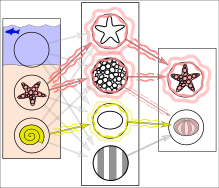
Back شبكة عصبية ذات تغذية أمامية Arabic Xarxa neuronal directa Catalan Dopředná neuronová síť Czech Red neuronal prealimentada Spanish شبکه عصبی پیشخور Persian Réseau de neurones à action directe French רשת זרימה קדימה HE Rete neurale feed-forward Italian 순방향 신경망 Korean Jednokierunkowa sieć neuronowa Polish
This article needs additional citations for verification. (September 2011) |
| Part of a series on |
| Machine learning and data mining |
|---|

In reality, textures and outlines would not be represented by single nodes, but rather by associated weight patterns of multiple nodes.
Feedforward refers to recognition-inference architecture of neural networks. Artificial neural network architectures are based on inputs multiplied by weights to obtain outputs (inputs-to-output): feedforward.[2] Recurrent neural networks, or neural networks with loops allow information from later processing stages to feed back to earlier stages for sequence processing.[3] However, at every stage of inference a feedforward multiplication remains the core, essential for backpropagation[4][5][6][7][8] or backpropagation through time. Thus neural networks cannot contain feedback like negative feedback or positive feedback where the outputs feed back to the very same inputs and modify them, because this forms an infinite loop which is not possible to rewind in time to generate an error signal through backpropagation. This issue and nomenclature appear to be a point of confusion between some computer scientists and scientists in other fields studying brain networks.[9]
- ^ Ferrie, C., & Kaiser, S. (2019). Neural Networks for Babies. Sourcebooks. ISBN 978-1492671206.
{{cite book}}: CS1 maint: multiple names: authors list (link) - ^ Zell, Andreas (1994). Simulation Neuronaler Netze [Simulation of Neural Networks] (in German) (1st ed.). Addison-Wesley. p. 73. ISBN 3-89319-554-8.
- ^ Schmidhuber, Jürgen (2015-01-01). "Deep learning in neural networks: An overview". Neural Networks. 61: 85–117. arXiv:1404.7828. doi:10.1016/j.neunet.2014.09.003. ISSN 0893-6080. PMID 25462637. S2CID 11715509.
- ^ Linnainmaa, Seppo (1970). The representation of the cumulative rounding error of an algorithm as a Taylor expansion of the local rounding errors (Masters) (in Finnish). University of Helsinki. p. 6–7.
- ^ Kelley, Henry J. (1960). "Gradient theory of optimal flight paths". ARS Journal. 30 (10): 947–954. doi:10.2514/8.5282.
- ^ Rosenblatt, Frank. x. Principles of Neurodynamics: Perceptrons and the Theory of Brain Mechanisms. Spartan Books, Washington DC, 1961
- ^ Werbos, Paul (1982). "Applications of advances in nonlinear sensitivity analysis" (PDF). System modeling and optimization. Springer. pp. 762–770. Archived (PDF) from the original on 14 April 2016. Retrieved 2 July 2017.
- ^ Rumelhart, David E., Geoffrey E. Hinton, and R. J. Williams. "Learning Internal Representations by Error Propagation". David E. Rumelhart, James L. McClelland, and the PDP research group. (editors), Parallel distributed processing: Explorations in the microstructure of cognition, Volume 1: Foundation. MIT Press, 1986.
- ^ Achler, T. (2023). "What AI, Neuroscience, and Cognitive Science Can Learn from Each Other: An Embedded Perspective". Cognitive Computation.

